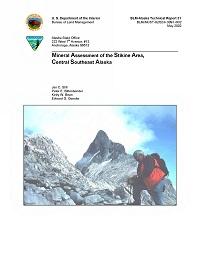Mineral Resources of the Stikine Area, Central Southeast Alaska

In 1997 the U.S. Department of the Interior, Bureau of Land Management (BLM) began a 4-year mineral resource assessment of the Stikine area in central Southeast Alaska. The 5.7-million acre study area encompasses the mainland bordering Frederick Sound and Kupreanof, Kuiu, Zarembo, Wrangell, Etolin, and nearby islands. The study area covers the Kupreanof and Petersburg Mining Districts, the Wrangell Subdistrict, and additional lands not included in adjacent mining district studies. As the primary land manager in the area, the U.S. Department of Agriculture, Forest Service, requested that the BLM assess the mineral potential in the Stikine area for the purpose of generating information that will aid the agency in future judgements regarding land management. This report serves as the final, comprehensive presentation of information gathered during the Stikine area study from 1997 to 2000. Over 175 mineral occurrences, industrial mineral sites, and geophysical anomalies were examined during this study. Also, over 130 localities were sampled to follow up road systems, USGS geochemical anomalies, and unpublished, mineral exploration company data.
The Stikine area hosts a variety of mineral deposit types, including volcanogenic massive sulfide (VMS), polymetallic replacement, polymetallic vein, vein gold, skarn, porphyry molybdenum, magmatic segregation, and veins of barite. In addition, there are minor deposits of placer gold, uranium, and coal. The Castle Island Mine produced 787,000 tons of barite between 1966 and 1980 (Carnes, 1980) from a VMS deposit. Minor gold production came from vein gold deposits of the Maid of Mexico (Chapin, 1918) and Helen S (Wright and Wright, 1908) mines in the early part of the twentieth century (U.S. Bureau of Mines, Mine Production Records). Based on the distribution and types of prospects, geology, geophysics, deposit models, and information from mineral exploration companies, this report delineates the Duncan Canal, Groundhog-Berg Basin, and Cornwallis Peninsula areas as "known mineral deposit areas" (KMDA’s). This implies that these areas have a higher relative likelihood for hosting a significant mineral deposit than other parts of the Stikine area.
The Duncan Canal KMDA, located along Duncan Canal, and on Woewodski and Zarembo islands, contains 19 sites with known or suspected VMS mineralization. These occurrences share Triassic host rocks of the Alexander terrane with deposits of known significance to the north, the Greens Creek Mine on Admiralty Island and the massive Windy Craggy deposit in northwestern British Columbia. The Groundhog-Berg Basin KMDA is located on the mainland near Wrangell. It contains 20 prospects with replacement, skarn, polymetallic vein, and vein gold mineralization and also some potential for porphyry copper and molybdenum deposits. The deposits in the area are rich in silver, lead, and zinc and have attracted significant exploration over the years.
The Cornwallis Peninsula KMDA on the north end of Kuiu Island is host to several polymetallic replacement and polymetallic vein deposits of lead and zinc and several small deposits of barite and witherite. As they are presently understood, these occurrences are too small and discontinuous to attract development. However, there are sufficient values and indications of extent to attract some exploration interest.
